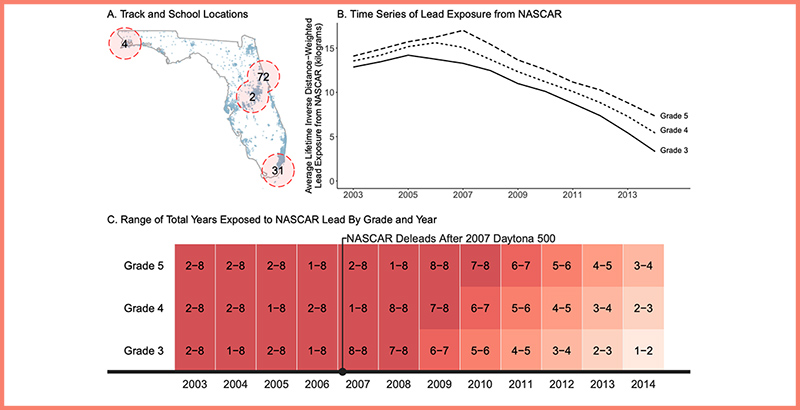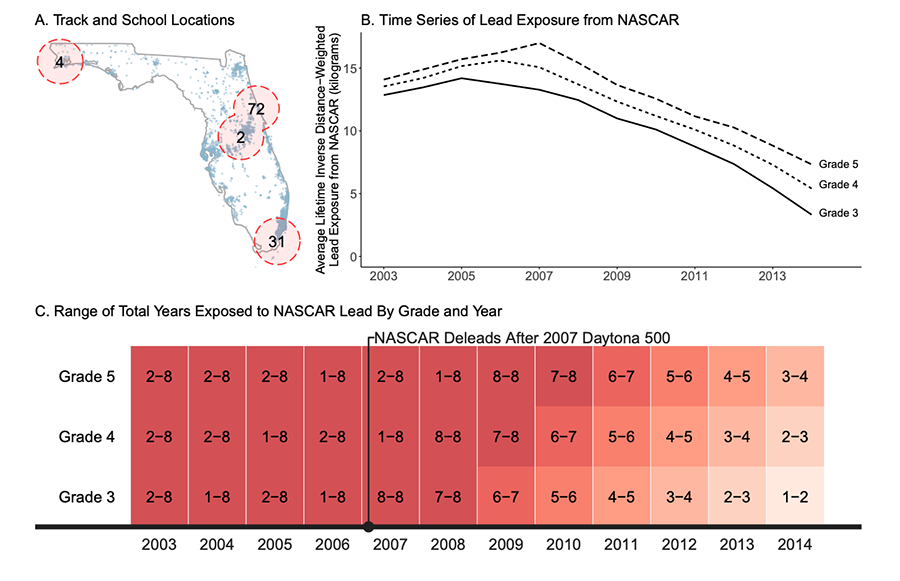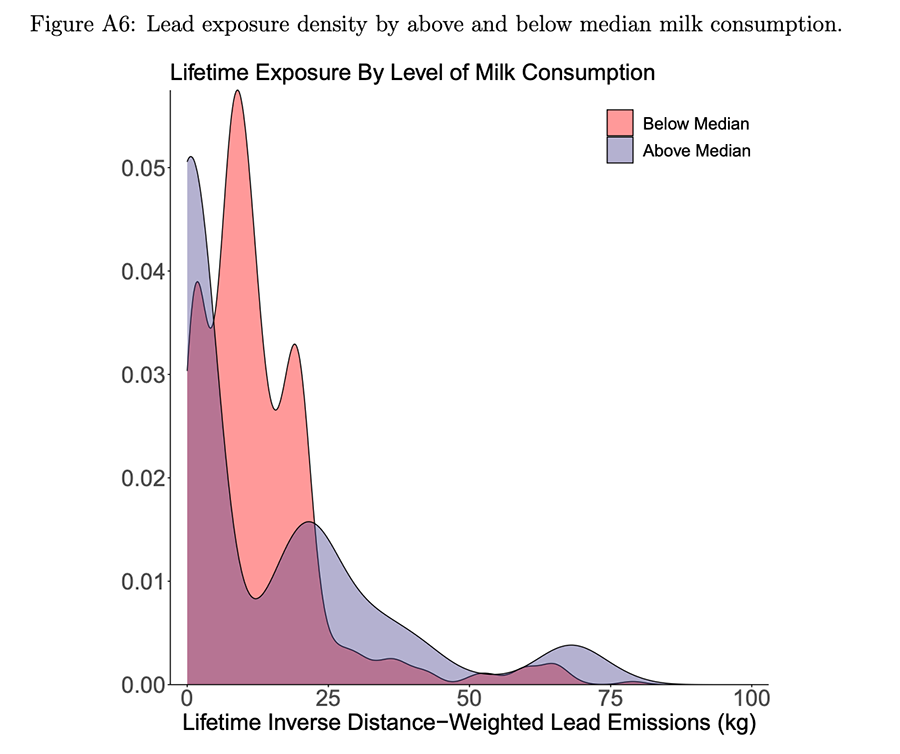Lead Poisoning Hurts Kids. A New Study Shows How Exposure from an Unexpected Source — NASCAR Racetracks — Lowered Test Scores

The Flint water crisis was, until the arrival of COVID-19, the most frightening recent instance of a public health emergency spilling over into K-12 education.
Beginning in 2014, thousands of children in the former manufacturing hub drank and bathed in water with dangerously high levels of lead, a substance known to inhibit intellectual development and increase impulsiveness, hyperactivity, and aggression. The aftermath saw hugely deleterious consequences for learning, as parents began reporting strange new behaviors from their children and demanding resources to deal with them. Five years after the catastrophe began, the city’s population of special-needs students had nearly doubled, all before a pandemic year that is still keeping them out of classrooms.
Remediation efforts, along with legal settlements and lost economic activity, will cost Michigan untold billions, to say nothing of the young lives permanently harmed by the months of poisoning. And those costs may ultimately result in criminal penalties, as nine current or former officials in Michigan’s state government, including former Gov. Rick Snyder, were indicted on charges in January relating to their roles in the Flint disaster. Two could be charged with manslaughter.
Even if they haven’t always been widely appreciated, the dangers of lead have increasingly been shown in both dramatic news accounts and a host of scientific studies. But while much of the existing research on the subject focuses on confirmed levels of blood lead — as measured in affected students like those in Flint — CDC data indicates that millions of young children and expectant mothers are never screened, and testing plummeted during the early months of the pandemic. Now a new study demonstrates the risks to health and brain function posed by unexpected sources of environmental contamination.
In a working paper circulated by the National Bureau of Economic Research, a group of economists found that elementary students exposed to airborne lead simply by attending schools near NASCAR racetracks scored significantly lower on standardized tests than similar children who were not. Those effects were found to be larger in predominantly nonwhite and lower-income communities. But according to study co-author Ivan Rudik, an assistant professor of economics at Cornell, proximity to the tracks was shown to harm learning for students of varying backgrounds.
“We can see the effect on test scores change…as you get further and further away from the racetracks,” Rudik said. “It’s really strong for the schools that are within two or three miles, and then as you get out a few [more] miles, that’s when it hits zero.”

The study takes advantage of a natural experiment triggered when NASCAR switched from leaded to unleaded fuel. Along with some other major emitters, including commercial airlines, the multi-billion-dollar racing association was exempted from provisions in the Clean Air Act that banned the use of heavy metals in fuel. The switch wasn’t made until 2007, after pleas from the EPA and the publication of research proving that participants in the company’s premier racing series had elevated blood lead levels.
Using data from Florida, the researchers examined reading and math scores of elementary-aged children enrolled in schools near NASCAR tracks between 2003 and 2014. They also estimated the amount of lead released annually from races at those tracks — including the racing association’s flagship Daytona International Speedway and Homestead-Miami Speedway — by incorporating the length of the tracks, the number of drivers competing, and the number of laps completed by each.
The amount of pollution emitted during that time was significant: In 2006, the average child attending school within 50 miles of a NASCAR track was exposed to 15 kilograms of lead by age nine, decreasing to a still-concerning 5 kilograms by 2014.
By the authors’ calculations, contamination with as much as 10 kilograms of lead is roughly the equivalent of growing up near an airport — previous research has demonstrated that living within one kilometer of an airport is associated with elevated blood lead levels — and removing that contamination could yield meaningful improvements in student performance: as much as reducing class sizes by 10 students, according to previous economic studies, or replacing a novice teacher with a more experienced one.
Notably, the impact of lead exposure on test scores was particularly strong in counties with higher poverty rates and higher percentages of African American students. Rudik argued that while families of comparatively higher socioeconomic status were also likely to live near NASCAR tracks, they had greater means to compensate.
“If parents see their kids are starting to do worse because of the lead exposure — even if they don’t know it’s because of the lead exposure — they can hire tutors and do a bunch of other things to help mitigate these negative effects,” he said. “Maybe they’re more likely to have their kids tested for blood lead, and they’re able to observe that their kid has been exposed, and they can take steps to mitigate it.”
A further nutritional wrinkle related to dietary choices. The negative testing effects, the researchers found, were largely kept in check in counties that saw rates of milk consumption above the median. That data came from Nielsen Homescan, a wide-ranging panel tracking consumer behavior, and fits with a well-known scientific finding that the presence of calcium decreases lead absorption in the body.

If nutritional interventions like greater milk consumption can be proven effective at scale, it would provide policy makers another weapon in combating the damage inflicted by lead poisoning. For the last few years, public commentatorshave called for a federal effort to clean up pollutants like lead, mercury, and smog from the vicinity of schools, often the legacy of nearby highways or long-closed industrial sites. While campaigning for the White House, Joe Biden proposed new spending to advance environmental justice by eliminating lead paint and pipes around the country.
Rudik said his study offered more evidence to an already strong case for the “unbelievable benefits” of a broad-based campaign to strengthen environmental protection.
“If you look at the recent literature, it basically says that the de-leading of gasoline in the 1900s is one of the most important things we could have done for public health. The nice thing about thinking about these pollution reductions is that it doesn’t just matter for education. It matters for a whole host of outcomes we care about — health, or even enjoying the outdoors — because pollution impacts all aspects of our life.”
Get stories like these delivered straight to your inbox. Sign up for The 74 Newsletter

;)
